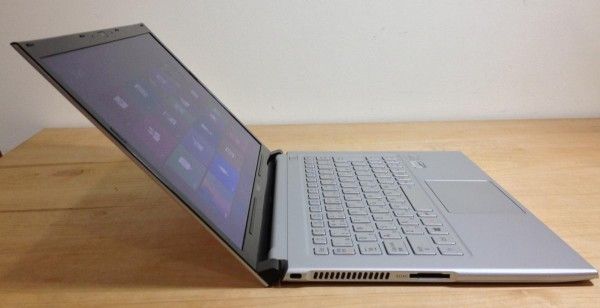Conclusion
If weight is your number one concern, the NEC Lavie Z should be at the top of your list. The sub 1kg weight in a 13.3-inch package is really quite impressive; it’s far and beyond the lightest Ultrabook in its class. The great thing about the Lavie Z is that its powerful despite its weight. It isn’t like the tiny netbooks of yore that have your friends saying “yeah it’s small and light, but where’s the power?” Instead, the Lavie Z has a top-end CPU, speedy SSD, and a solid display with an ideal 1600×900 resolution (and thin bezel!). This is ultra-portable power that you’ll be glad to take with you ever day.
Japanese keyboard and ports aside, the only thing that left us wanting with the Lavie Z was graphical power. HD 4000 is generally enough for casual gaming — and it is on the Lavie Z — but it seemed to underperform compared to other HD 4000 Ultrabooks. Again, this could be an issue with Windows 8, drivers, or tuning by NEC; it isn’t quite clear. That said, the majority are not gamers and for those the Lavie Z will get you through just fine with the fastest CPU, and one of the fastest SSDs, on any Ultrabook we’ve tested.
The NEC Lavie Z is available imported directly from Japan from our pals at Dynamism.
Full NEC Lavie Z Review Gallery















Great review Ben.
Zero bloatware is a true advantage and I think most Dynamism imports are built this way. Good job Dynamism.
Looking forward to batery life tests.
Chippy.
Cool stuff but will never every buy a ultrabook with 2 or less USB-ports again. Hope this trend doesnt stay, my freaking 500$ old 10inch notebook had freaking 3 usb-slots.
great device all ultrabooks should aspire to that weight sadly it is not readily available in europe it is something for the japanese market right?
In theory Lenovo has rights to rebrand and release it outside of Japan due to their deal with NEC.
Is the power plug compatible with the Thinkpad X1C adapter? It sure looks that way.
Hoping the battery life scores are decent. Probably still not enough for me, but maybe the Haswell version might be.
The HD 4000 is most probably underperforming other ultrabooks because the processor overperforms. CPU+GPU share overall TDP so more energy consuption by the CPU limits the energy available to the GPU, which is in effect throttled more aggressively.
Hence on Ultrabook with today’s generation of core it generally makes more sense not to have the fastest cpu, and even to have an i5 instead of an i7, even if it seems less sexy.
It could also be set to battery mode instead of performance mode. (in the GPU control panel)
I used our guide on maximizing Ultrabook perfromance (http://ultrabooknews.com/2012/07/12/how-to-optimize-your-ultrabook-for-maximum-gaming-performance/) before running the tests, so it should have been at top performance. I’m thinking that NEC turned down the graphics to help the battery life.
Did you get a chance to check CPU clockrate during tests. They may be using a tdp-down option which will limit CPU and affect the overall perf. The Samsung Series 5 for example, doesn’t have turbo enabled when on battery.
Strange indeed!
But one BIGGEST problem with them, – ONLY 4gb memory,that’s just a jole :(
I watched Intel’s Turbo Boost performance monitor during benchmarks and it seemed to be running at full power (but I think the graphics core might be separate).
Hi, could you elaborate a bit more on the vertical viewing angle? How much off center can you be before it starts to wash out? Also, how sturdy is the LCD hinge when the screen is open? Does it stay firmly in place or will it wiggle around? Lastly, any problems with the touchpad? I read some Japanese reviews and it seemed like people were complaining about it. Thanks.
Can you give review/test on color accuracy?
Thanks!